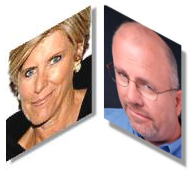UPDATED April 2020: It’s been nearly a decade since I challenged Suze and Dave to a debate, but they haven’t taken me up on it yet. This post sparked some very lively debate and insightful comments, so be sure to read those, too.
Suze Orman, Dave Ramsey and many other financial advice-givers tell you to avoid whole life insurance. However, the policies used for the Bank On Yourself method are dramatically different in three key ways from the kind of whole life insurance that Suze, Dave and others talk about. Here, I reveal these key differences and prove their validity by showing you examples of my own policy statements.
What’s more, my readers have alerted Suze and Dave. But sadly, both have chosen to ignore the facts I reveal below. I’m sure neither Suze nor Dave relish the idea of having to rewrite all their books and materials. But once YOU learn the critical key differences between Bank On Yourself policies and the ones Suze and Dave mention, I’m confident you’ll be asking the same question we hear Bank On Yourself policyholders mention repeatedly: “How come no one’s ever told me about this before!?”
Here are the three key differences:

![]() Key Difference #1: These experts say the money you can have access to in the plan (your “cash value”) grows too slowly in a whole life policy, and say you typically won’t have any cash value at all in the first few years.
Key Difference #1: These experts say the money you can have access to in the plan (your “cash value”) grows too slowly in a whole life policy, and say you typically won’t have any cash value at all in the first few years.
 Suze Orman & Dave Ramsey
Suze Orman & Dave RamseyA Bank On Yourself-type policy, however, incorporates a special – and little-known – rider or option that turbo-charges the growth of your money in the policy so you have up to 40 times more cash value, especially in the early years of the policy. This allows you to use it as a powerful financial management tool from Day One.
Don’t take our word for it – here’s a statement from a Bank On Yourself-designed dividend-paying whole life policy, at the end of just one year.
And here’s an article that reveals the rate of return of a properly designed Bank On Yourself type policy. It puts traditional investments to shame, and it does that without the risk or volatility of stocks, real estate, gold, commodities and other investments.
But each plan is different, so to find out how much cash value you’ll have each year – guaranteed – request your FREE Analysis here.
![]()
Key Difference #2: Most financial experts, including Suze and Dave, talk about policies where your death benefit stays level for the life of the policy.
However, in a dividend-paying whole life policy, dividends can be left in the policy to purchase additional coverage, while at the same time growing your cash value in the most efficient way possible. This policy statement shows you how the death benefit keeps growing, and proves these policies are different from the ones Suze and Dave talk about.
Please note that this statement is from a policy I started before I learned about Bank On Yourself, and it has grown much more slowly than a policy designed to maximize the power of the Bank On Yourself concept.
Even so, this policy has left my mutual funds and real estate investments in the dust.
![]()
Key Difference #3: The financial experts often rant about how, when the policy owner dies, the insurance company “only” pays you the death benefit and keeps your cash value.
But with a Bank On Yourself policy it’s very different, as you can see on this policy statement. It shows you how, had I died on the date this statement was issued, my family would have received a check for more than the original death benefit AND the cash value in the policy combined!
So I am throwing out the gauntlet to Suze, Dave or any expert who wants to challenge me. Just name the time and place!”
And remember, Bank On Yourself will beat anyone’s best financial strategy or we’ll pay you $100,000!
No two policies are alike, because each one is tailored to the client’s unique situation. So your results will be different. To find out what your bottom-line numbers could be, and how much your financial picture could improve if you added Bank On Yourself to your financial plan, request a free Bank On Yourself Analysis. There’s no obligation.
Update! Our hidden video camera captured Suze Orman and Dave Ramsey discussing Bank On Yourself…

If Bank On Yourself is so good, why isn’t everyone already doing it?
If you browse the personal finance section of any bookstore, turn on the TV or open a magazine on finance, you’ll discover that 99 out of 100 financial “gurus” will insist that whole life insurance is a lousy place to put your money. Most will recommend you buy term life insurance instead and invest the difference in mutual funds.
That’s in spite of the fact that, had you invested in an S&P 500 index fund for the past 13 years, you most likely have little to show for it other than a pile of pocket lint and a lot of sleepless nights. And that doesn’t even factor in 35% inflation during this period!
But I’m getting a little ahead of myself. Part of the problem is these financial experts know nothing about the specially designed type of dividend-paying whole life policy used for the Bank On Yourself method, as I’ve demonstrated above. [Read more…] “Dave Ramsey and Suze Orman on Whole Life Insurance: Let’s Debate!”
